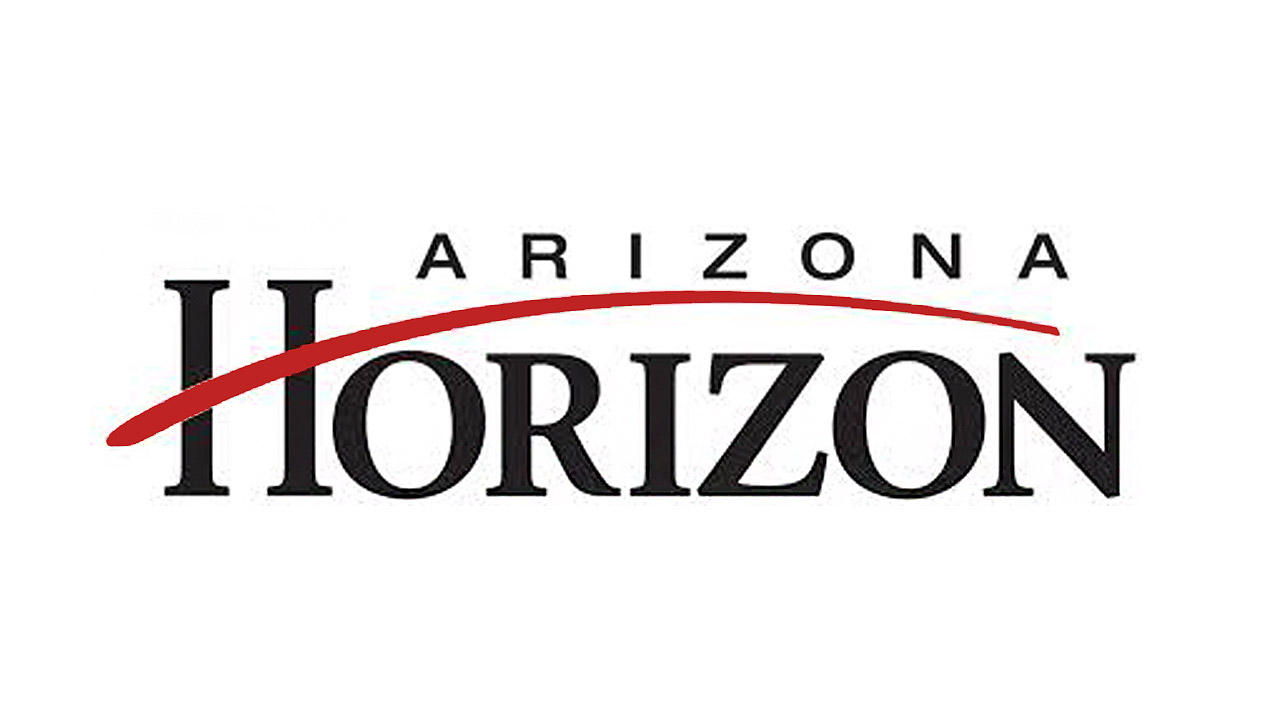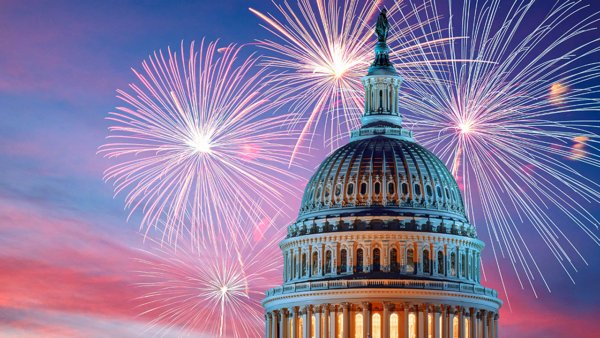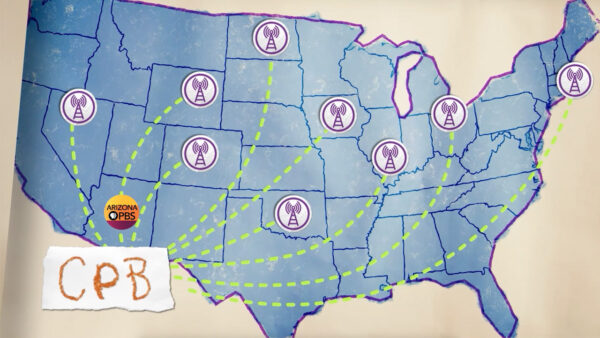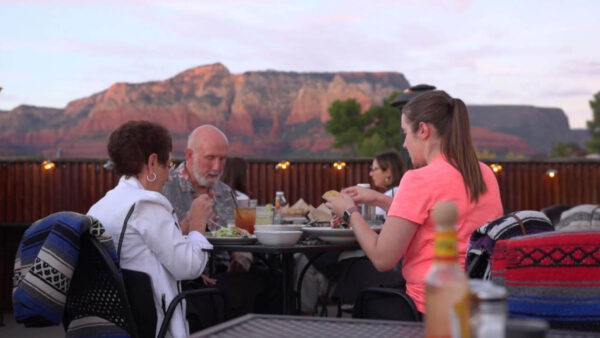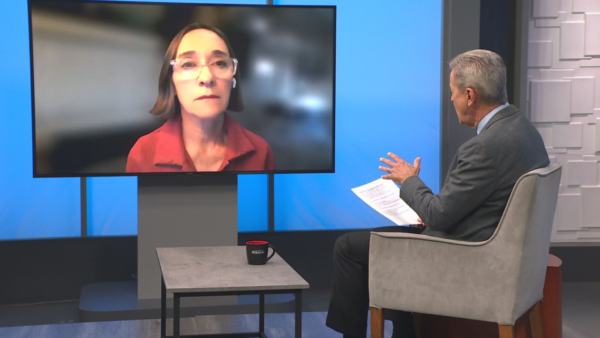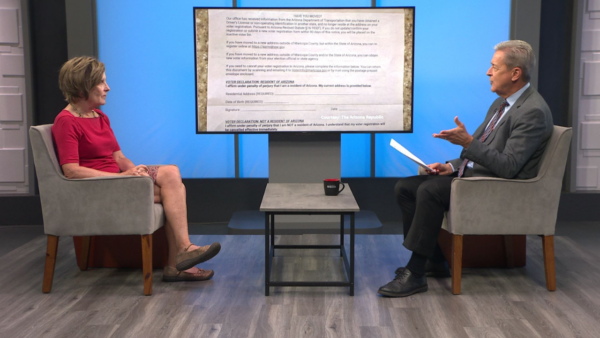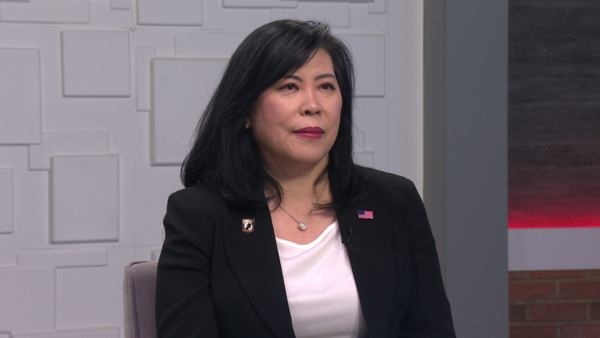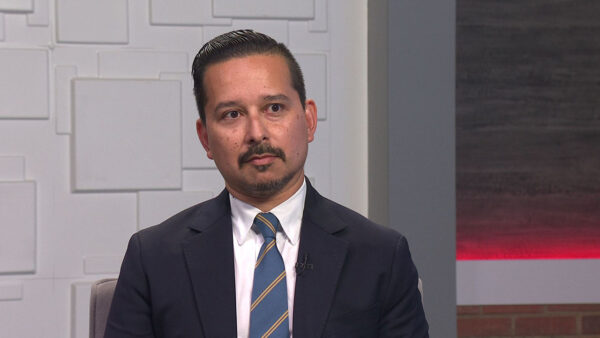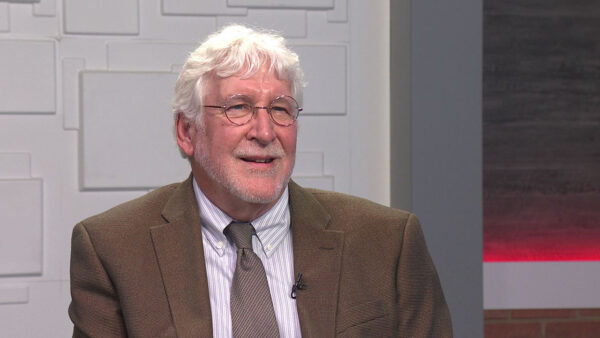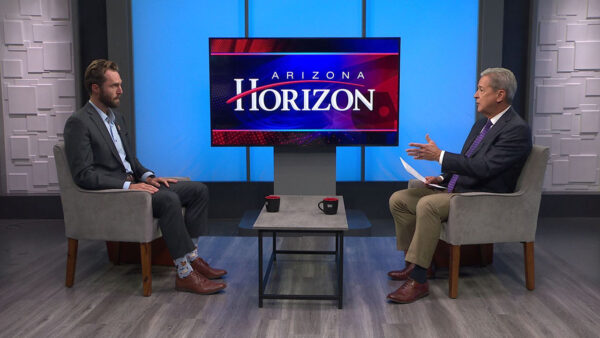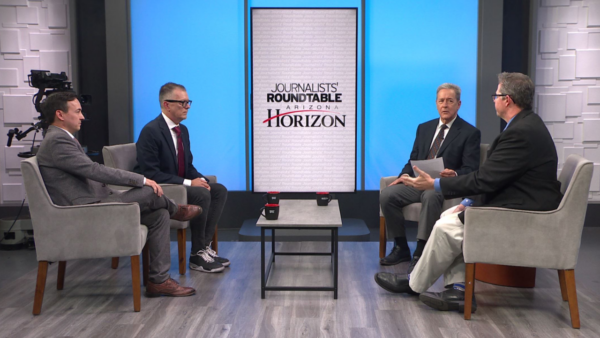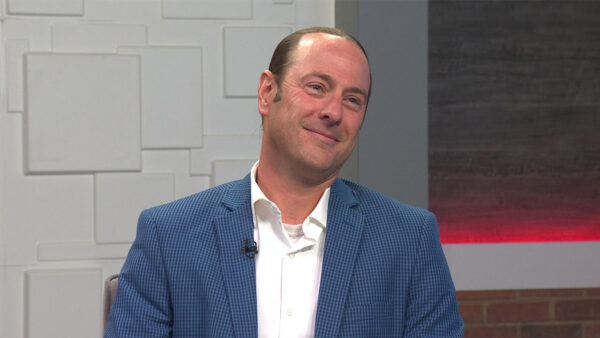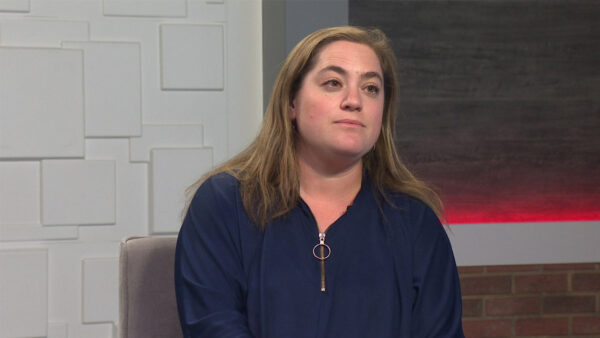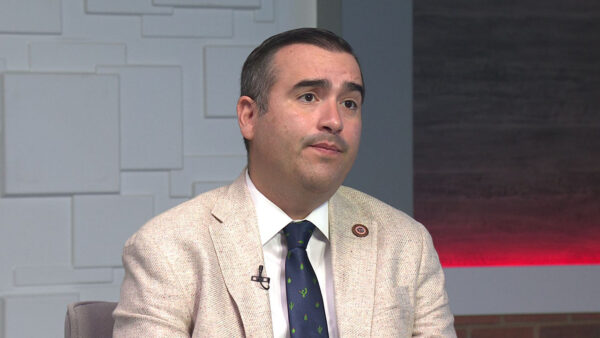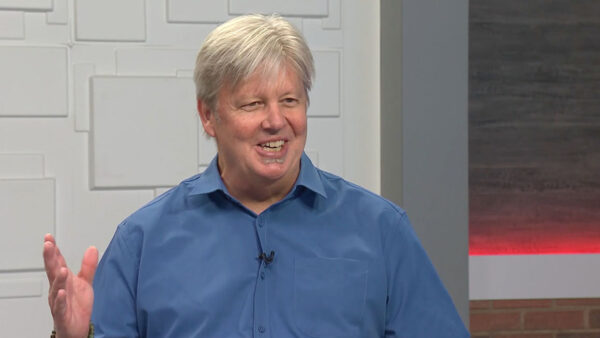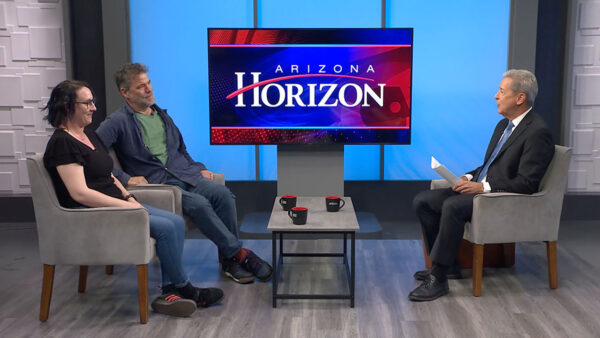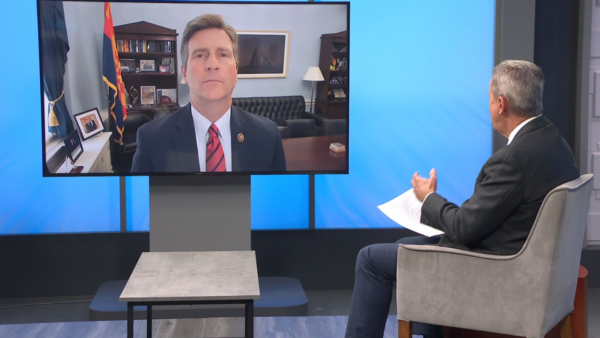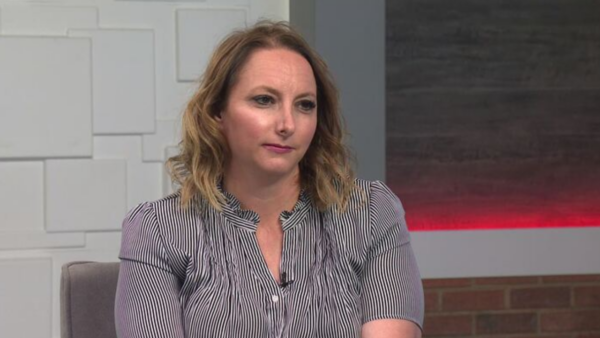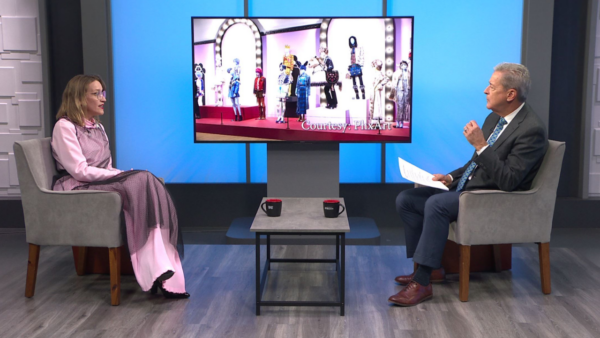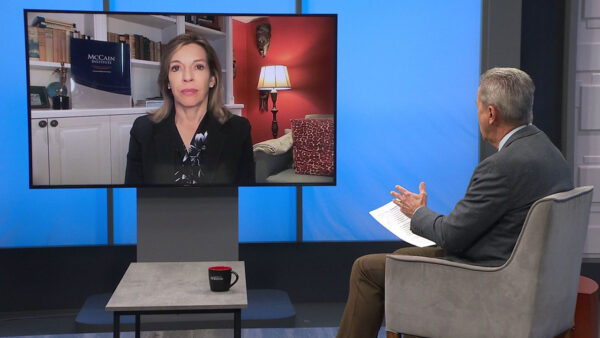The battle at Picacho Pass was the western-most civil war battle. Learn how Arizona was once a confederate state, and how the battle near Picacho Peak played a role in keeping Confederate troops from reaching California.
>> Michael Grant:
Tonight on "Horizon," President Bush finally has an energy bill on his desk and Arizonans will be affected. The property crime rate in Arizona has made this state number one in crime overall. Housing costs are creating problems for first-time homebuyers. And the north and south battle for the west at Picacho Peak in tonight's "Arizona Story." Good evening, welcome to "Horizon," I'm Michael Grant. President Bush expected to sign into law the first major energy policy over haul in more than 10 years. The Senate passed the bill a day after the house did so last week. There was clear bipartisan support for the bill which will give about $14.5 billion in tax breaks and incentives to increase oil and natural gas production, among other things. Joining me to talk about what the energy bill may mean to the state is Arizona Corporation Commissioner Kris Mayes. Kris, welcome back.
>> Kris Mayes:
Thanks, Mike.
>> Michael Grant:
Interestingly enough both senators and Congressman Flake voted against it. What do we read that from, do you think?
>> Kris Mayes:
Several things. I mean, I think they had a number of different reasons for voting against it. Personally, I like to consider it the good, the bad and the ugly bill. It's got a little bit to love and a lot to really dislike, but I think Senator McCain and Senator Kyl and Congressman Flake all had some concerns about the level of pork in it. It was really porked up in a lot of ways.
>> Michael Grant:
Certainly it is a costly piece of legislation.
>> Kris Mayes:
Yes, there was some concern there. The two senators, I think, were concerned to the degree in which it would have imposed the ethanol standard on our gasoline doesn't make a heck of a lot of sense for us, makes a lots of sense for the corn growers of Iowa but not necessarily Arizonans. So they made a principled vote against it, and I think Congressman Flake also was with the Corporation Commission in opposing the line citing preemption by the federal government which I know we will talk about.
>> Michael Grant:
Let's talk about what there is to love here. I think there's some aspects for consumers to like. One of them is there's some increased tax credits for energy efficiencies, retro fits that you might do to your home.
>> Kris Mayes:
Yeah, this is good stuff. This is going to be very helpful for people who want to start to save some on their energy costs, which as we know are going way, way up. By doing some things like putting in more efficient windows, by putting in some insulation that works better, and maybe putting in new water heaters. This would be about a $500 capped tax credit for those kinds of projects. It's a good deal and people really ought to take advantage of it.
>> Michael Grant:
If you are interested in getting a hybrid car, now, unfortunately the credits available here are not extensive, but anyway, there are some credits accorded that purchase.
>> Kris Mayes:
Yeah, and I think, frankly, this credit is going to make these hybrid cars even more popular. Apparently they're impossible to get right now but the credit is about -- anywhere from 300 to $3,000 depending on the car you get. I think that each manufacturer is limited to something like 60,000 cars that they can sell under this credit, so it's somewhat limited and it's not going to be a boondoggle necessarily for folks, but it is -- it's a good deal. Makes those cars a little more affordable.
>> Michael Grant:
Now, if you're interested in putting some sort of a solar energy installation on your house or whatever, there's tax credits in here for that, and actually some pretty good tax credits.
>> Kris Mayes:
This I really think is the lining -- the bright lining of the cloud here, the shining part of this legislation, something that we can really hang our hats on and it is basically a solar tax credit that would be -- for residential homeowners to put solar systems on their homes that's capped at $2,000, and it lasts for about two years, and the commercial businesses can also get a tax credit. They already have one right now under the existing federal law of about 10%. That would go up to -- I think it's a larger amount than that, but, anyway, it's a $22,000 tax credit from the federal government. The State of Arizona already offers a $1,000 tax credit, and on top of that, as you know, Mike, the corporation --
>> Michael Grant:
There are some programs from the various utilities.
>> Kris Mayes:
that are man mandated by the Corporation Commission and under that EPS program, people can get $10,000 off of the cost of a $20,000 system put in by APS. You add it all up and you get $13,000 off of a $20,000 system, which is starting to make these solar systems more affordable for the average person. It also is driving down the buy down period. This is really important. Because what it's doing is it's saying to homeowners, you put one of these on and that $7,000 you're having to pay on the upfront, you can get that paid off over 10 years rather than 13, 14, 15 years. Then after that, you're saving all kinds of money on your utility bill. It's really cost effective for you. For businesses, it's even better. Your buy down program is now three to five years. This is a great thing. I had spoke to one solar installer who told me after "The Arizona Republic" ran this information in the paper his phone was ringing off the hook. So this is good stuff.
>> Michael Grant:
There's also the reinstitution of a wind tax credit. Does that make maybe some additional wind projects in Arizona more economically viable than they otherwise would have been?
>> Kris Mayes:
I think so. This is called the production tax credit, and it is essentially set up to encourage the development and construction of these big wind mills, which California has a lot of, and they're doing --
>> Michael Grant:
Texas has done big time.
>> Kris Mayes:
Texas has exploited wind. Arizona doesn't have the great wind resource, we do in areas like St. John's, up in Mojave County, places outside of Flagstaff but this is make it more economical for developers to come in and do these projects.
>> Michael Grant:
Almost out of tine. But there is concern about a line citing -- a possibility of federal preemption of the local process.
>> Kris Mayes:
This is the ugly part of the legislation from my perspective. This would basically preempt the state's rights to decide some major line citing proposals. Right now the State of Arizona has basically total jurisdiction over where power lines are to be sighted and under this federal legislation, the secretary of the energy in Washington D.C, some bureaucrat in Washington D.C., could come in and basically overturn a decision by the Arizona Corporation Commission, and I think it's really dangerous. I think you've got California sitting out there that would really like to take a lot of our energy across the border, and there's some power lines that are on the "Horizon." We'd like to have some say over those decisions.
>> Michael Grant:
All right. Corporation Commissioner Kris Mayes, thanks very much for the information. I guess we'll get further details as we move down the road.
>> Kris Mayes: Thanks, Mike.
>> Michael Grant:
Arizona's crime rates are unfortunately the highest per capita in the nation, that is a conclusion from a report from the justice commission. It was determined that Arizona is continuing a trend that began in 2000. Here's a look at some of the findings.
>> Larry Lemmons:
The 2005 Arizona crime trends report includes the following findings: Arizona's population grew more than three times faster than the rest of the nation in the 10-year span between 1993 and 2003. In fact, in the last four years, Arizona has been the second fastest growing state behind Nevada. The rapid growth in population may be one reason why Arizona is number one in the nation in overall crime, even though Arizona's crime rate dropped nearly 4% from last year. The national average dropped more. Of major crime, violent crime was down a little over 7%. Arizona is ranked 13th in the nation. Of violent crime, robbery was down nearly 7%. Aggravated assault was down over 9%. But murder was actually up over 11%, making Arizona fifth in the nation for that crime. Rape was up nearly 13%. The reason why Arizona ranks so high overall is because of property crime. Even though property crime dropped 3 1/2% since last year the national average dropped lower, making Arizona number one. Burglary dropped 3%. Nevertheless, Arizona is number four. Arizona is number two in larceny theft, despite a 3.6% drop from last year. What clearly makes Arizona exceed the national average is motor vehicle theft. Far more vehicles are stolen in Arizona than any other state. Arizona remains number one, despite a 3.4% drop. According to the report, less than 50% of all violent crime is reported to the police. On the criminal courtside, there was nearly an 82% increase in criminal case filings between 1994 and 2004. The total probation population increased over 20% between 1999 and 2004. The total population committed to the Arizona department of corrections as of the end of last year was 32,570. That's nearly 2,000 higher than the designated bed capacity. The adult committed population in the department of corrections increased 127.6% from 1990 to 2004. Finally, surprisingly, despite an increase in the overall juvenile population, the number of juveniles in the department of juvenile corrections decreased between 2001 to 2004.
>> Michael Grant:
With me now to talk about the numbers is the director of the commission's statistical analysis center, Steve Ballance. Steve, thanks for coming down. Who makes up the criminal justice commission and what's the general objective of the report?
>> Steve Ballance:
The commission is comprised of 19 commission members, five of which are state agency heads, 14 of which are elected -- appointed by the governor. The statistical analysis, my department, is the research arm of the Arizona criminal justice commission, and there's somebody like me in every state. So there's a SAC director, if you will, in each state, and basically provides research information for that state.
>> Michael Grant:
Basically to sort of telegraph to the various members of the commission and for that matter other policymakers, we're going up, we're going down, we're remaining flat, whatever the case may be.
>> Steve Ballance:
And this is one report that we do. We are required by statute to do several reports. We do reports on -- substance abuse. Probably the thing we're most known for is that survey where we surveyed you 40,000 kids in 2004 but we do reports on gang behavior, motor vehicle theft, case processing. Some of them mandated by statute, some of which are requests by the commission. Or the governor's office or by federal funded programs.
>> Michael Grant:
Steve, obviously we just saw a series of statistical conclusions that can really drive you nuts. Can you sort of go back up to like 5,000 feet or so and -- what are the two or three takeaway lessons from this report or takeaway trends or what do we pull out of this?
>> Steve Ballance:
Well, one thing I think that's important to note is that, as you noticed on the numbers, that in Arizona the last year they all went down except for two categories. Those two categories being murder and rape. But even though that occurred, we're still number one in crime relative to the other states.
>> Michael Grant:
It seems counterintuitive.
>> Steve Ballance:
It is in some respect and I think it's a little confusing, but the reality is other states have not dropped as fast or relatively speaking moved a different direction than Arizona. So the numbers in terms of why we're number one in overall crime, a lot of is that relative to property crime because of the shear numbers. The property crime makes up a majority of all the crime in Arizona. It makes up about 92%. Nationally it's about 88% of all crime. So if you're number one in property crime, more than likely you'll be number one --
>> Michael Grant:
You'll be number one nationwide? And in particular, as the subset, car theft, why do we have in Arizona such a large problem with car theft?
>> Steve Ballance:
On all of these questions, there's' really no easy answers. If we had the answer we would definitely go out and try to address the problem, but the proximity to the border certainly makes it a very open market in terms of being able to move cars across the border. The fact that we have such a rising population, we have been number two in terms of growth -- I think just behind Nevada for the last few years. And over the last 10 years we have basically tripled the growth rate of the rest of the country. So there's lots of reasons in terms of the motor vehicle theft. Motor vehicle theft oftentimes is associated with other types of criminal behavior such as drug trafficking, human smuggling, gang behavior, and all of those things make it just, again, an open market for motor vehicle theft.
>> Michael Grant:
Almost out of time but the population increase drives crime, I guess, because of the instability that it injects?
>> Steve Ballance:
It -- in some ways the instability, the movement back and forth. One of the risk factors for crime is transitions and mobility and certainly we have that in the case in Arizona. But it also increases workloads, which is probably a bigger issue, is that as you have increasing populations, you have increased populations at the department of corrections, across the entire system. That coupled with the fact that we have dwindling resources. Grants are being cut across the system. Just makes it real difficult to maintain current service delivery.
>> Michael Grant:
Steve Ballance thank you very much. Recently "Horizon" presented a four-part series on the booming housing market. As you might expect not just happening in the Valley. Tucson also a hot market. In fact, one of the 10 hottest in the country. If you own a home that's good news for you but what about first time homebuyers looking for affordable housing? Tony Paniagua looks at that part of the housing story.
>> Tony Paniagua:
New homes are going up all over Arizona but so are their prices and a lot of people simply can't keep up. So despite the building boom, affordable housing is a hot commodity.
>> Michael McDonald:
There is a tremendous need in the community. When we go out to the community and say we have an open house, we want to build another 10 homes or 20 homes, we have 1200 people say that they need a habitat house.
>> Tony Paniagua:
Habitat for humanity is talking about projects like this one in central Tucson. Balboa Laguna consists of 36 patio homes for low-income owners like Lubita Gallegos who can settle down and raise a family. Gallegos has two girls and a full-time job but buying a house was out of the picture.
>> Lubito Gallegos:
I thought that working and supporting two kids I wouldn't be able to be a homeowner. But this opportunity came to came to me and I said this is the time to have my own home.
>> Tony Paniagua:
But with habitat's help her dream has come true. A roof over her head. Her old piece of property -- own piece of property providing pride. And tears of joy.
>> Lubito Gallegos:
I never thought that I was going to have a home. Especially for my kids. It berets lot of happiness. Not only for me, for my family.
>> Tony Paniagua:
A nonprofit agency say there are many for people like her, in fact, Pima County has an estimated 216,000 households with an income of less than $50,000, which is the median income for a family of four. The median price for a home sold in May was more than $200,000, making them unaffordable for many families.
>> Michael McDonald:
The need is tremendous and it's growing all the time. I mean, yes, all of us who have a home right now are saying, oh, my home value is going up. But if you were to sell that home, what could you buy in today's market?
>> Tony Paniagua :
Chicanos por la causa is another agency trying to help out first time low-income homebuyers. This development west of downtown near Silver Bell is a mixed income subdivision. 38 of 61 houses are reserved for buyers who qualify.
>> Noemi Navarro:
It has been really, really good. Very interesting to see the families come with their kids and just walking through the house, "this is my house" they cry, it's just amazing. It's shocking. We sometimes want to cry with them because it's like, okay, our dream come true has done well for everybody.
>> Tony Paniagua:
Chicanos por la causa says the project is made possible by the community at large. For example, the county and city donated the land. The city also donated the land for Balboa Laguna in central Tucson turning a dream into reality. Each of these houses costs about $95,000 to build with the donated land they're appraised at about $125,000. That's a lot less than the average cost of a new house in the Tucson market however many still would have been unaffordable to the residents here had it not been for habitat for humanity, their donors and their volunteers. But experts predict if costs continue to rise so rapidly it may price out many more potential buyers, even college graduates and working professionals. So they say everyone needs to cooperate, especially when it comes to incomes.
>> Michael McDonald:
If we do not provide good, stable housing in good neighborhoods for people, what employers are going to move here to hire folks? We've got to invest in education. We've got to invest in housing and neighborhoods and have a livable wage.
>>Tony Paniagua
If not, many may look for their piece of the pipe somewhere else.
>> Noemi Navarro:
Right now you have a lot of people moving into this market. Now you're going to see people leaving. What's that going to cost Tucson? We are going to lose. I think it's interesting we need to start evaluating everything, analyzing everything and having all heads together like the private-public sector.
>> Tony Paniagua
Gallegos understands the needs for cooperation. Her hope now is others can experience the joy of owning a home.
>> Lubito Gallegos:
If my dream came true like for me and my family, anybody else, their dream could come true for them, too.
>> Tony Paniagua:
It seems to be getting tougher every year but experts hope private-public partnerships can keep the dream alive for many more families.
>> Michael Grant:
It was the westernmost Civil War battle in the United States and it was fought just over an hour's drive south of the Valley. The battle near Picacho Peak was just a skirmish really but it was part of an overall effort by the south to move into California. Producer Mike Sauceda and videographer Scot Olson tell us the story of the engagement at Picacho pass.
>> Mike Sauceda:
A commemoration of the civil war battle of Val Verde fought in February of 1862 and in what is now New Mexico. In that battle hundreds of confederate and union forces died. The battle is one of three that occurred in the territory of New Mexico, which included present day Arizona. With those battles the south was trying to take over the territory in an effort to expand to the Pacific Ocean.
>> Wade Cox:
During the first year of the civil war the confederacy was making a concerted effort to gain control of the southwest, partly for its mineral resources, but even more importantly to expand its boundaries considerably to make it considerably more difficult for the union to maintain a successful blockade. Towards that end, confederate troops, mostly from Texas, were squaring off against U.S. troops, New Mexico volunteers and Colorado volunteers in what is now the state of New Mexico.
>>Mike Sauceda:
The Val Verde battle is commemorated near the site of Arizona's only civil war battle which occurred at Picacho Peak near Eloy. Another battle commemorated near Picacho Peak is the battle of Glorietta pass which also took place in what is now present day New Mexico.
>> Wade Cox:
We also commemorate subsequent battle fought up in the Santa Fe area, the battle of Glorietta pass and Apache canyon which were two distinct engagements but closely related tactically.
>> Mike Sauceda:
In 1861, the New Mexico territory was split in two. As the Confederates claimed everything south of the 34th parallel, which included the Phoenix area. They named their new territory Arizona. Arizona's capital was MESILA which is north of present day El Paso. In February of 1862, confederate troops moved into Tucson where they were received with open arms because they provided protection from Indian raids. They caught the attention of union troops stationed at fort Yuma.
>> Wade Cox:
There were 1800 volunteer U.S. troops stationed at fort Yuma which is just across the river from the town of Yuma, across in California. And to forestall further advances by confederate forces they started moving eastward up the Gila River and one of the stopping places was the Pima villages near what's now Sacaton and then on down this way. This was a major thoroughfare called the Gila trail by many historians. Anybody going from east to west or west to east came this way.
>> Mike Sauceda:
That thoroughfare squeezed between two mountains in an area called Picacho pass and is still used today for interstate 10. To get to Tucson union troops would have to go through the pass, a small group of confederate troops were at the pass waiting for them. Before the skirmish in mid-April of 1862, union cavalrymen captured some Confederates.
>> Wade Cox:
So they had captured these three. So the actual shooting when it started was between seven confederates and what was left of the union troops. The battle, surprisingly, it was reported at the time as having lasted about an hour-and-a-half.
>> Mike Sauceda:
The Union troops were led by captain William Calloway and lieutenant James Barrett.
>> Wade Cox:
They were aware of the presence of a small contingent of confederates in this area and so Calloway spent a small detachment under the command of lieutenant Barrett, actually lieutenant Barrett and 13 soldiers, down here and he sent another larger detachment around the idea being because they knew there was a small contingent of confederates here, the idea being to approach them from two different sides and capture them. For some reason the larger of the two contingents never made it to this site in time. So lieutenant Barrett against the advice of his scout led his men on horseback into what was then described as a mesquite thicket. Having done that, they were basically ambushed. One of the reasons for that is that being in the mesquite Basque, it probably provided considerable protection from the bullets. What ultimately happened, if you are just talking about injuries and body counts, probably you could say that the confederates won the battle of Picacho Pass.
>>Mike Sauceda:
There are questions about the exact date of the battle and it's not commemorated exactly where the battle fought. One thing is for sure, the south did win the battle but soon lost the war for control of the New Mexico territory.
>> Merry Lucero:
From kindergarten through 12th grade, charter schools and our state's university and community colleges, Arizona's public education system is challenged by record enrollment and future population growth. We look at some of the latest changes in Arizona's education system in our education report card Wednesday at 7:00 on "Horizon".
>> Michael Grant:
Thanks very much for being here on a Monday evening. I'm Michael Grant. Have a great one. Good night.
Kris Mayes:Arizona Corporation Commissioner;Steve Ballance:director, statistical analysis center, Arizona Criminal Justice Commission;
